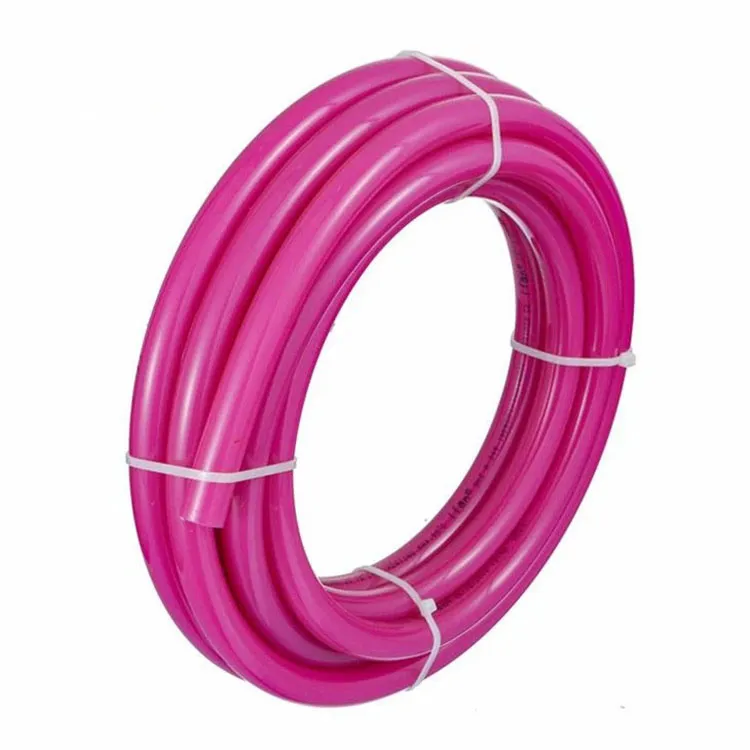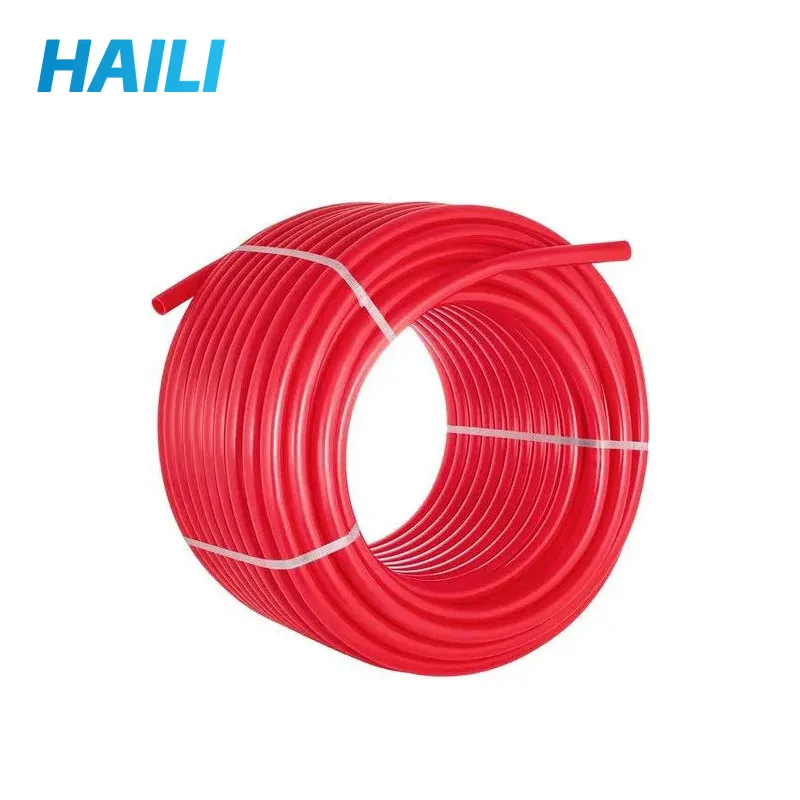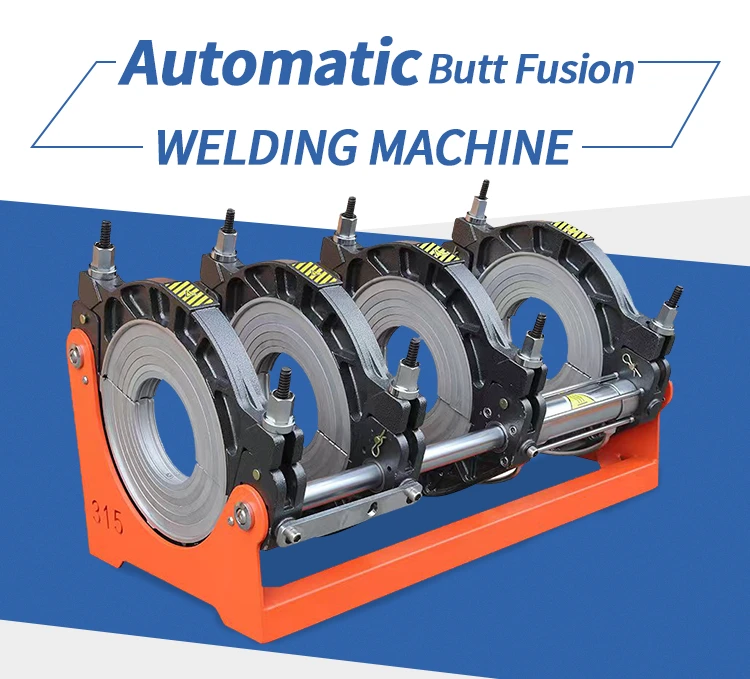Thermal insulation pipe is suitable for transporting various media in the range of -50℃-150℃. It is widely used in central heating, cooling, and hot oil transportation, as well as thermal insulation and cold insulation projects in greenhouses, cold storage, coal mines, petroleum, chemical, and other industries.
Insulation pipe technical indicators
| Technical performance | Unit | Technology |
| Capacity | Kg/m3 | 45-60 |
| Thermal Conductivity | W/m.k | 0.016-0.024 |
| Operating temperature | ℃ | -90-120 |
| Closed cell ratio | % | ≥97 |
| Water absorption | Kg/m2 | ≤0.2 |
| Oxygen Index | h | ≥26 |
| Compressive strength | Mpa | ≥200 |
194147.webp)
940423.webp)
Prefabricated directly buried thermal insulation pipes have a three-layer structure from the inside to the outside:
First layer: The working steel pipe layer generally uses seamless pipes (GB8163 to 87), spiral welded pipes (GB9711 to 88; SY/T5038 to 92) and straight seam welded pipes (GB3092 to 93) according to the design and customer requirements. After the surface of the steel pipe is treated by shot blasting and rust removal, the rust removal grade of the steel pipe can reach the Sa2 level in the GB8923-1988 standard, and the surface roughness can reach R=12.5 microns in the GB6060.5 to 88 standard.
Second layer: The polyurethane insulation layer is made by injecting rigid polyurethane foam stock solution into the cavity formed between the steel pipe and the outer sheath at one time using a high-pressure foaming machine. It is commonly known as the "tube-in-tube foaming process". Its function is firstly to waterproof, secondly to keep heat, and thirdly to support the weight of the heating network. When the temperature of the conveying medium is: -50℃-150℃, rigid polyurearate foam plastic is used as the insulation layer.
The third layer: The high-density polyethylene protective layer is pre-made into a black (yellow) plastic pipe with a certain wall thickness. Its function is to protect the polyurethane insulation layer from damage by mechanical hard objects and to be anti-corrosion and waterproof.
The production process of polyurethane directly buried insulation pipe: steel pipe rust removal - polyurethane foaming - forming - finished product inspection - warehousing
1. Rust removal
2. Tubing and bracket bundling
A. High-density polyethylene outer protective pipe selected according to core pipe and insulation layer →.
B. Steel pipe after rust removal → Bundle the bracket in sections (1.5 meters/section) → Pass the bundled bracket core pipe into the high-density polyethylene outer protective pipe until the exposed parts at both ends of the core pipe are 150mm-250mm.
C. Seal the clamps (flange or external clamps) that match the diameter of the core pipe and the thickness of the insulation layer at both ends of the pipe and lock them.
Note: The structure, height, material, bundling method, and compressive strength of the bracket should be selected based on the core tube diameter and design requirements.
3. Polyurethane casting foaming
Adjust the mixing ratio of the foaming machine to 1:1.05 → measure the flow rate of the equipment → set the pouring time (feeding amount/flow rate). Open a pouring hole in the middle of the HDPE outer protective pipe after the two ends of the pipe are blocked → insert the pouring nozzle of the foaming machine mixing head into the pouring hole → pour → plug the empty material into the pouring hole → mature → remove the card Head → Inspection → Correct the input quantity → Finished product.
Advantages and Features of Prefabricated Directly Buried Insulated Pipes
1. Reduce project cost. According to calculations by relevant departments, double-pipe heating pipes can generally reduce the project cost by about 25% (using fiberglass as the protective layer) and 10% (using high-density polyethylene as the protective layer).
2. Low heat loss, saving energy. Its thermal conductivity is: λ = 0.013 to 0.03kcal/m·h·oC, which is much lower than other pipe insulation materials commonly used in the past, and the insulation effect is increased by 4 to 9 times. Furthermore, its water absorption rate is very low, about 0.2kg/m2. The reason for the low water absorption rate is that the closed cell rate of polyurethane foam is as high as about 92%. Low thermal conductivity and low water absorption, coupled with the insulation layer and high-density polyethylene or fiberglass protective shell with good waterproof performance on the outside, have changed the situation of traditional trench laying heating pipes "wearing wet cotton jackets", greatly reducing the risk of heating pipes The overall heat loss and the heat loss of the heating network are 2%, which is less than the international standard requirement of 10%.
3. Anti-corrosion, good insulation performance and long service life. Because the polyurethane rigid foam insulation layer is tightly bonded to the outer skin of the steel pipe, it isolates the infiltration of air and water and can play a good anti-corrosion role. At the same time, its foaming holes are closed and its water absorption is very small. High-density polyethylene shell and fiberglass shell have good anti-corrosion, insulation and mechanical properties. Therefore, the outer skin of the working steel pipe is difficult to be eroded by outside air and water. As long as the internal water quality of the pipeline is well treated, according to foreign data, the service life can reach more than 50 years, which is 3 to 4 times longer than traditional trench laying and overhead laying.
4. It occupies less space, is quick to construct, and is conducive to environmental protection. Directly buried heating pipes do not require the construction of huge trenches, and only need to bury the insulation pipes underground, thus greatly reducing the project area, reducing the amount of earth excavation by about 50%, and reducing the amount of civil masonry and concrete by 90%. At the same time, the insulation pipe processing and on-site trenching are carried out in parallel, and only on-site joints are needed, which can shorten the construction period by about 50%.
5. Safety. The polyurethane directly buried thermal insulation pipe is equipped with a leakage alarm line. Once a leak occurs somewhere in the pipeline, through the conduction of the alarm line, the leakage of the insulation pipeline, the exact location of the leakage and the leakage can be displayed on a special detection instrument. The size of the leakage pipe section can be notified to the leakage inspection personnel to quickly deal with the leaking pipe section to ensure the safe operation of the heating pipe network.
Structural classification
Steel sleeve steel composite
Steel-in-steel composite insulation pipe insulation structures can be divided into two categories based on different sliding methods:
1. Internal sliding type: The insulation structure consists of working steel pipe, aluminum silicate, drag reduction layer, microporous calcium silicate, heat insulation layer, stainless steel fastening steel strip, aluminum foil reflective layer, polyurethane insulation layer, outer steel pipe, and outer anti-corrosion layer composition. The internal sliding insulation steel pipe is composed of a steel pipe for transporting media + composite silicate or microporous calcium silicate + rigid polyurethane foam + outer steel pipe + glass fiber reinforced plastic shell anti-corrosion protective layer structure. The insulation treatment technology for various pipe fitting nodes is mature and the quality is reliable.
2. External sliding type: The insulation structure is composed of working steel pipe, glass wool insulation layer, aluminum foil reflective layer, stainless steel fastening steel belt, sliding guide bracket, air insulation layer, outer protective steel pipe, and outer anti-corrosion layer.
polyurethane
The polyurethane insulation pipe has a three-layer structure from the inside to the outside: the first layer: working steel pipe layer
According to the design and customer requirements, seamless steel pipes, spiral steel pipes and straight seam steel pipes are generally used. After the surface of the steel pipe is treated with advanced shot blasting and rust removal technology, the rust removal grade of the steel pipe can reach the Sa2 level in the GB8923-1988 standard, and the surface roughness can reach R=12.5 microns in the GB6060.5-88 standard.
Second layer: polyurethane insulation layer:
A high-pressure foaming machine is used to inject the raw liquid of rigid polyurethane foam into the cavity formed between the steel pipe and the outer sheath at one time, which is commonly known as "tube-in-tube foaming".
Third layer: high-density polyethylene protective layer:
Prefabricated black or yellow polyethylene plastic pipes with a certain wall thickness. Its function is to protect the polyurethane insulation layer from damage by mechanical hard objects, and to be anti-corrosion and waterproof.
Characteristics of thermal insulation pipe
High temperature prefabricated direct buried thermal insulation pipe-advantages and features
1. It has strong corrosion resistance and waterproof ability and low overall cost.
According to calculations by relevant departments, double-pipe heating pipes can generally reduce the project cost by about 25% (using fiberglass as the protective layer) and 10% (using high-density polyethylene as the protective layer).
2. Low heat loss, saving energy. Heat loss is only 25% of traditional pipes
Directly buried thermal insulation pipe Thermal conductivity 0.022kcal/m.h.℃ Hydrophobicity 0.03kg/cm³
3. Long service life
Correct installation and use can extend the life of the pipe network to 30-50 years with extremely low maintenance costs.
4. It occupies less space, can be constructed quickly, and is conducive to environmental protection.
It can reduce the amount of earth excavation by more than 50% and the amount of earthwork masonry and concrete by 90%.
It is much lower than other commonly used insulation pipe materials in the past, and the insulation effect is increased by 4 to 9 times. Furthermore, its water absorption rate is very low, about 0.2kg/m2. The reason for the low water absorption rate is that the closed cell rate of polyurethane foam is as high as about 92%. Low thermal conductivity and low water absorption, coupled with the insulation layer and high-density polyethylene or fiberglass protective shell with good waterproof performance on the outside, have changed the situation of traditional trench laying heating pipes "wearing wet cotton jackets", greatly reducing the risk of heating pipes The overall heat loss and the heat loss of the heating network are 2%, which is less than the international standard requirement of 10%.
Anti-corrosion, good insulation performance and long service life.
The polyurethane rigid foam insulation layer of the insulation pipe is tightly bonded to the outer skin of the steel pipe, which isolates the infiltration of air and water and can play a good anti-corrosion role. At the same time, its foaming holes are closed and its water absorption is very small. High-density polyethylene shell and fiberglass shell have good anti-corrosion, insulation and mechanical properties. Therefore, the outer skin of the working steel pipe is difficult to be eroded by outside air and water. As long as the internal water quality of the pipeline is well treated, according to foreign data, the service life of high-temperature prefabricated directly buried insulation pipes can reach more than 50 years, which is 3 to 4 times longer than traditional trench laying and overhead laying.
It occupies less space, is quick to construct, and is conducive to environmental protection.
Directly buried heating pipes do not require the construction of huge trenches, and only need to bury the insulation pipes underground, thus greatly reducing the project area, reducing the amount of earth excavation by about 50%, and reducing the amount of civil masonry and concrete by 90%. At the same time, the processing of insulation pipes and on-site trenching are carried out in parallel, and only on-site joints are needed, which can shorten the construction period by more than 50%.
Insulated pipe safety system
Directly buried thermal insulation pipes manufactured outside of China are all equipped with leakage alarm lines. Once leakage occurs somewhere in the pipeline, through the conduction of the alarm line, the exact location and location of water seepage and leakage in the insulation pipeline can be displayed on a special detection instrument. The extent of leakage can be used to notify leakage inspection personnel to quickly deal with the leaking pipe section and ensure the safe operation of the heating pipe network. The domestically produced insulation pipes are not equipped with leakage alarm lines, and this gap needs to be filled.
In short, insulation pipes not only have advanced technology and practical performance that are unmatched by traditional trenches and overhead pipes, but also have significant social and economic benefits, and are also a powerful measure for heating and energy saving. The adoption of directly buried heating pipeline technology marks that the development of China's heating pipeline technology has entered a new starting point. With the further improvement and development of this advanced technology, it is imperative that heating pipes be directly buried instead of trenches and overhead.
Application
Pert insulation pipes are widely used in construction and industrial fields, mainly used in hot water supply, heating systems, floor heating systems, etc. Here are some common applications for Pert insulation pipe:
1. Heating system: Pert insulation pipes are used in the central heating system of buildings. They can transport high-temperature hot water or steam to various parts of the building to ensure the heating effect of the entire building.
2. Cooling system: Pert insulation pipes are also suitable for cooling systems, which can deliver coolant to the air conditioning equipment in the building to provide a comfortable indoor temperature for the building.
3. Floor heating system: Pert insulation pipes are commonly used in floor heating systems. The floor heating system lays heating pipes under the floor to provide constant temperature indoor heating through radiant heat transfer.
4. Industrial use: In the industrial field, Pert insulation pipes can be used to transport high-temperature fluids, such as hot oil or high-temperature water, to meet the temperature control needs of some production processes.
5. Construction projects: Pert insulation pipes can also be used in other hot water supply and heating systems in construction projects, such as hotels, hospitals, schools and other buildings.
6. Chemical industry: In some special environments, Pert insulation pipes can be used to transport chemicals or industrial liquids because Pert material has good chemical stability.
7. Domestic water system: In residential and commercial buildings, Pert insulated pipes can be used to transport hot water, such as supplying sanitary hot water and kitchen hot water.
The advantages of Pert insulation pipe are its high temperature tolerance, flexibility and resistance to chemical attack, making it a reliable material in heating, cooling and floor heating systems. Specific application scenarios will vary based on project needs and design requirements.
Development status
Insulated pipes are an important factor affecting energy conservation. The development and application of insulation pipes have attracted more and more attention from countries around the world. After the 1970s, foreign countries generally paid attention to the production and application of thermal insulation pipes, striving to significantly reduce energy consumption, thereby reducing environmental pollution and the greenhouse effect. The foreign thermal insulation industry has a long history, and new thermal insulation materials are constantly emerging. Before 1980, the development of thermal insulation pipes in my country was very slow. A few thermal insulation factories could only produce a small amount of directly buried underground thermal insulation pipes. However, after more than 30 years of hard work, especially after nearly 10 years of rapid development, many thermal insulation pipes in China have Products are developed from scratch, from single to diversified, from low to high quality, and their applications are becoming more and more common. Polyurethane material is currently the most commonly used thermal insulation material in the world. Rigid polyurethane has many excellent properties and is widely used in the field of thermal insulation in European and American countries. About 49% of thermal insulation materials in developed countries such as Europe and the United States are polyurethane materials, while in China this proportion is less than 20%.
990.webp)
688.webp)
113.webp)
954.webp)
630.webp)
476.webp)

288.webp)






659.webp)
210.webp)


